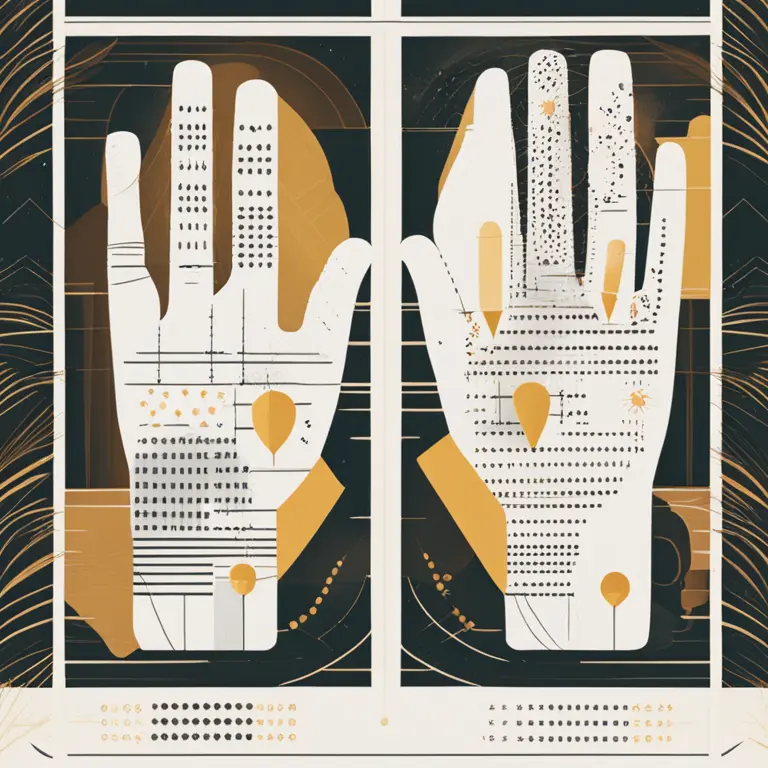
Right Hand & Palmistry Readings
Discover which hand holds the key to your personal palmistry insights and how to interpret its mysteries effectively.
article by Nora Pennington
The Significance of Hands in Palmistry
Palmistry, the ancient art of hand reading, looks at the lines, shapes, and features of the hands to reveal personality traits and life's potential. But a common question arises for both beginners and enthusiasts alike: which hand should one use for a palm reading? Traditionally, palmists consider both hands as significant, yet they may hold different meanings. The right hand often represents the conscious mind and outward personality, whereas the left hand is thought to reflect the subconscious and potential. This basic understanding sets the stage for a more nuanced exploration of palm analysis.

Right Hand vs. Left Hand
In palmistry, the dominant hand—the one you use to write—is regarded as your active or conscious hand. It reveals what you are actively working on or the energies you are expressing in the world. On the flip side, the non-dominant hand is seen as the passive or potential hand, associated with inherited traits or latent abilities. By comparing both hands, palmists may uncover how innate potential shapes the direction of your life's journey and how personal efforts transform inherent qualities over time.

The Evolution of Palmistry Practices
As we move further into 2024, palmistry has evolved to integrate more personalized interpretations, which takes into account the individual's handedness, personal beliefs, and life experiences. Whether a palmist emphasizes the traditional right/left hand distinction or adopts a more flexible approach depends on their particular methodology. This blend of classic knowledge with modern understanding enables a nuanced analysis, offering clients a more tailored and relevant palmistry reading.

Cultural Variations in Palm Readings
Cultural perspectives also play a role in the determination of hand preference for readings. In some Eastern traditions, the left hand is read for women and the right for men. However, as palmistry is practiced globally, these conventions are less rigid, focusing more on individual life events and future tendencies without strict adherence to gender norms. This shift illustrates the contemporary movement towards inclusivity and the recognition of diverse experiences in the esoteric arts.
Asking the Right Questions
Selecting the hand for palm reading is not a one-size-fits-all decision; it often requires a dialogue between the palmist and the client. Understanding the client's goals for the reading—whether they are more interested in understanding their innate personality or their current life trajectory—can guide the palmist in choosing the appropriate hand. Inquiries about their dominant hand, current life changes, and areas of focus can all inform the decision-making process.
The Impact of Personal Growth and Change
As individuals, we are continuously growing and transforming, and our palms mirror these changes. The lines on our hands are not static; they morph and shift over time, reflecting our decisions and experiences. For ongoing personal insights, palmists may suggest regular readings, providing an opportunity to observe the hands' progression and map personal development over periods.
Preparing for a Palmistry Session
For those preparing to delve into their palmistry journey, it is advisable to enter the session with an open mind and ready for self-reflection. Understanding that the hands offer a glimpse into both your stable traits and your dynamic life narrative can inspire a fulfilling and enlightening palmistry experience. Professionals are leaning into more holistic practices that encompass the physical, mental, and spiritual, so expect your palm reading to reflect these intertwined aspects of your being.
Published: 1/11/2024
Modified: 1/12/2024
More predictions
Come back here soon to learn more about yourself and your future


The Efficacy of Palmistry: Real Insight or Fancy?
Delve into the validity of palmistry as a form of divination. Is there a truth behind the lines on our palms, or is it just a charming fancy?


Palmistry: The Historical Overview
Delve into the dawn of palmistry and trace its journey through the corridors of time, uncovering the roots of this ancient practice.


The Ancient Art of Vedic Palmistry
Discover the ancient art of Vedic Palmistry and its practice in the modern era, revealing the secrets held within the lines of the hand.